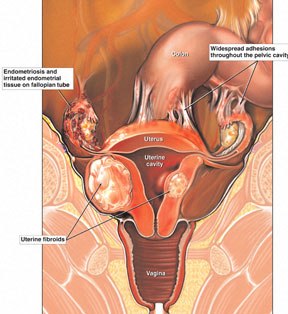Uterine tumors or growths can be either benign or malignant.
Benign tumors do not cause symptoms. One such benign uterine growth is uterine fibroid.
The fibroids are also known as fibromyomas, leiomyomas or myomas.
As the fibroids arise from the tissue in the myometrium (muscle layer in the wall of the uterus), it is also termed as myomas.
It is one of the most common tumors in women, which are made up of muscle cells and other tissues that develop within the wall of the uterus (or womb). It is medically termed as uterine leiomyomata, which is an unusual growth of smooth muscle tissue.
The fibroids in the walls of the uterine may exist as a single tumor or in clusters (or groups). Even it varies in size from very small (like an apple seed) or less than one inch to larger than a grapefruit or eight inches (20cm) across or more. The average size is around 2cm.
It mostly occurs in women of reproductive age. It is present in one out of every four women. The cause of uterine fibroids is unknown. However, it mostly develops in obese women, women who have no children, and probably with some genetic determinant and rarely in smokers.
Mostly you notice no problems with the presence of fibroids and usually aware of its presence in your body during other diagnostic or therapeutic procedures.
Symptoms of Uterine Fibroids
Uterine fibroids are often asymptomatic, but if they cause symptoms it can be annoying with severe pelvic pain, stress on the bladder, pressure on the rectum leading to pain during bowel movements, and cause frequent urination.
You may also have heavy, painful and lengthy menstrual bleeding. Though uterine fibroids are harmless, they usually cause hysterectomy because of this abnormal bleeding. Moreover, occasionally, the heavy bleeding can cause anemia (loss of blood).
If you find severe localized pain, then it generally indicates a deterioration of the uterine fibroids.
Although uterine fibroids are benign, complications may develop if left untreated. These include frequent miscarriages, infertility, and complications in childbirth. However, these usually occurs as long as there is unusual distortion of the uterus.
Call your health care provider if you notice changes in your menstrual pattern or other symptoms. Luckily, you have several non-surgical methods on hand to treat the uterine fibroids. For this, fibroids in the uterus are detected through pelvic examination and ultrasound scan.
Once if the uterine fibroids are detected in the uterus, then your doctor will start treating them accordingly. However, the treatment completely depends upon severity of the symptoms, your age, plan for children, and general health.
If your uterine fibroids aren’t causing any symptoms and are relatively small then it is simply a case of regular routine monitoring.
On the other hand, if your uterine fibroids are causing cramps or painful periods then Ibuprofen or Naprosyn, non-steroidal anti-inflammatory medications, will be prescribed. Even birth control pills, iron supplements can be used in the treatment of uterine fibroids.
Also, surgical interventions are available to treat uterine fibroids. These include Myomectomy, Hysteroscopic Resection and Uterine Artery Embolisation (UAE).







Have uterine fibroid 4x 4 cm solid, Painful during cycles.
otherwise no symptoms. My age 48 years but cycles regular but paimful. have to take pain killers. for 3 days. No compalain rest of the days. Pain ful period complain is since my start of menarch.
please advise